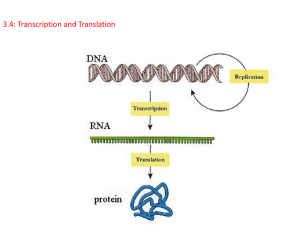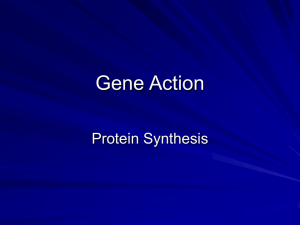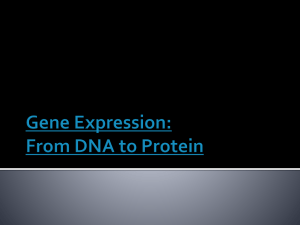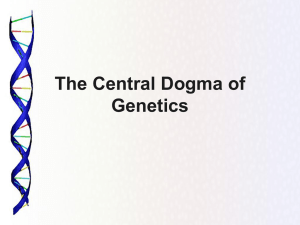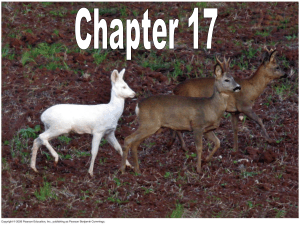Chapter 17 Guided Notes
advertisement
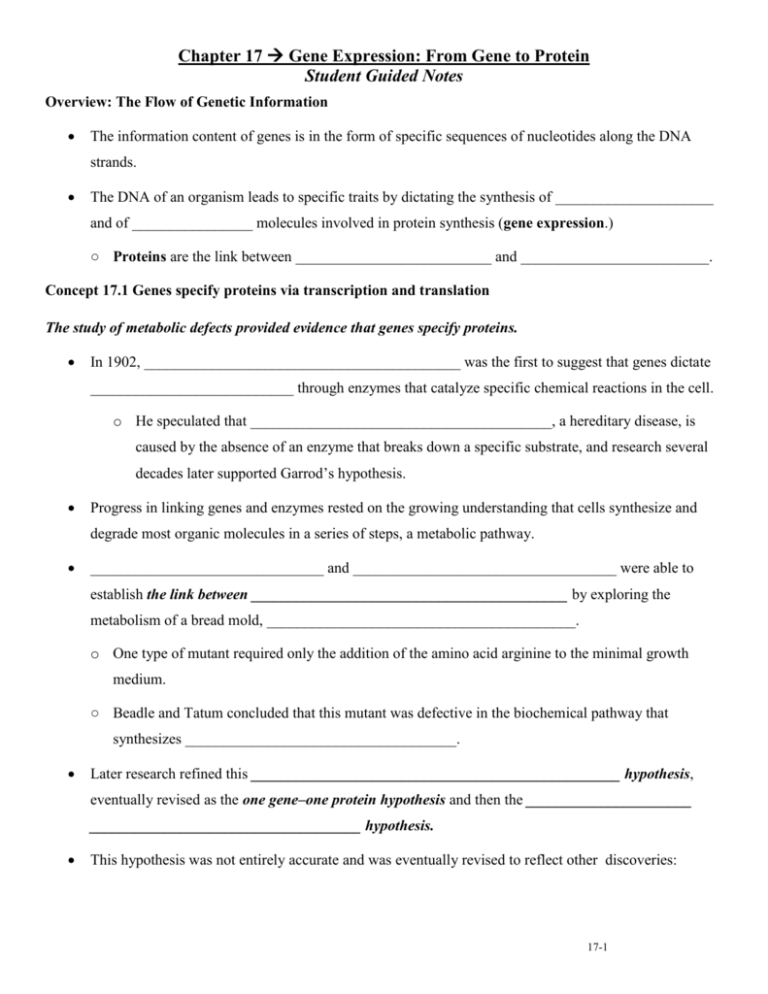
Chapter 17 Gene Expression: From Gene to Protein Student Guided Notes Overview: The Flow of Genetic Information The information content of genes is in the form of specific sequences of nucleotides along the DNA strands. The DNA of an organism leads to specific traits by dictating the synthesis of _____________________ and of ________________ molecules involved in protein synthesis (gene expression.) ○ Proteins are the link between __________________________ and _________________________. Concept 17.1 Genes specify proteins via transcription and translation The study of metabolic defects provided evidence that genes specify proteins. In 1902, __________________________________________ was the first to suggest that genes dictate ___________________________ through enzymes that catalyze specific chemical reactions in the cell. o He speculated that ________________________________________, a hereditary disease, is caused by the absence of an enzyme that breaks down a specific substrate, and research several decades later supported Garrod’s hypothesis. Progress in linking genes and enzymes rested on the growing understanding that cells synthesize and degrade most organic molecules in a series of steps, a metabolic pathway. _______________________________ and ___________________________________ were able to establish the link between __________________________________________ by exploring the metabolism of a bread mold, _________________________________________. o One type of mutant required only the addition of the amino acid arginine to the minimal growth medium. ○ Beadle and Tatum concluded that this mutant was defective in the biochemical pathway that synthesizes ____________________________________. Later research refined this _________________________________________________ hypothesis, eventually revised as the one gene–one protein hypothesis and then the ______________________ ____________________________________ hypothesis. This hypothesis was not entirely accurate and was eventually revised to reflect other discoveries: 17-1 o The newest definition of a gene (find this at the end of the chapter!): _____________________ _________________________________________________________________________________ _________________________________________________________________________________ ________________________________________________________________________________. _______________________ and ____________________ are the two main processes linking gene to protein. Genes provide the instructions for making specific proteins. Getting from DNA to protein requires two major stages: transcription and translation. During transcription, a DNA strand provides a ________________________________ for the synthesis of a ____________________________________________________________________. o Transcription of a protein-coding gene produces a _______________________________________ ______________________________ molecule. Translation is the synthesis of a ________________________________________________, using the information in ____________________________. o The sites of translation are the _________________________________________, complex particles that facilitate the orderly assembly of amino acids into polypeptide chains. The basic mechanics of transcription and translation are similar in eukaryotes and bacteria. Bacteria lack nuclei, and their DNA is not separated from ribosomes and other protein-synthesizing equipment. ○ This allows the coupling of _______________________________ and _______________________. In a eukaryotic cell, transcription occurs in the _______________________________, and translation occurs at ______________________________________ in the cytoplasm. The molecular chain of command in a cell has a directional flow of genetic information: _____________________ ___________________ __________________________ Francis Crick dubbed this concept the ____________________________________ in 1956. In the genetic code, nucleotide triplets specify amino acids. Triplets of nucleotide bases are the smallest units of uniform length that can code for all the amino acids. ○ With a triplet code, three consecutive bases specify an __________________________________, creating _____________________ possible code words. 17-2 During transcription, one DNA strand, the template strand, provides a template for ______________ ___________________________________________________________________________________. The mRNA base triplets are called _______________________. ○ These codons are complementary to the template strand and thus identical in sequence to the __________________ except that they have ______ instead of __________. During translation, the sequence of codons along an mRNA molecule is translated into a sequence of _______________________________________ making up the polypeptide chain. ○ Each codon specifies which one of the 20 amino acids will be incorporated at the corresponding position along a polypeptide. o The task of matching each codon to its amino acid counterpart began in the early 1960s. o ________________________________ determined the first match: UUU codes for the amino acid __________________________________________. o ____________________ of 64 triplets code for amino acids. o The codon AUG not only codes for the amino acid _____________________________ but also indicates the “__________________” or initiation of ______________________________. o Three codons do not indicate amino acids but are “__________________” signals marking the termination of translation. ○ The starting point establishes the ___________________________________________; subsequent codons are read in groups of three nucleotides. The genetic code must have evolved very early in the history of life. The genetic code is nearly universal, _____________________________________________________ ___________________________________________________________________________________. Concept 17.2 Transcription is the DNA-directed synthesis of RNA: a closer look _____________________________________________ separates the DNA strands at the appropriate point and joins RNA nucleotides complementary to the DNA template strand. ○ Like DNA polymerases, RNA polymerases can assemble a polynucleotide only in its 53 direction (therefore the template strand is ____________________.) Specific sequences of nucleotides along the DNA mark where gene transcription begins and ends. 17-3 ○ RNA polymerase attaches and initiates transcription at the __________________________. The promoter has a sequence of A’s and T’s and is called the ___________________________. This helps identify where the promoter is located. ○ The sequence that signals ______________________________________ is called the terminator. Transcription can be separated into three stages: ______________________________, __________________________________, and ___________________________________ of the RNA chain. The promoter (where RNA polymerase binds) determines where ______________________________ and which strand of DNA is the _________________________________. In eukaryotes, proteins called ___________________________________________ mediate the binding of RNA polymerase and the initiation of transcription. The complex of transcription factors and RNA polymerase bound to a promoter is called a __________________________________________________________. ○ As RNA polymerase moves along the DNA, it untwists the double helix, ______ to _______ nucleotides at a time and adds nucleotides to the __________ end of the growing strand. Many polymerase molecules simultaneously transcribing a single gene increases the amount of mRNA transcribed from it and helps the cell make the encoded protein in large amounts. The mechanism of termination differs between bacteria and eukaryotes. o In bacteria, transcription stops ______________________________________________________ ________________________________________________________________________________. o In eukaryotes, RNA polymerase transcribes the signal for about _____________________________ past the _________________________________. Concept 17.3 Eukaryotic cells modify RNA after transcription During RNA processing, both ends of the primary transcript are altered. o At the 5 end of the pre-mRNA molecule, a modified form of ______________________________ is added, called the ______________. o At the 3 end, an enzyme adds _________ to __________________________________________, called the _________________________________________. These modifications have several important functions. ○ They facilitate the export of mRNA from the _______________________________. 17-4 ○ They help protect mRNA from _______________________________________. ○ They help the ________________________________________ to the _______ end of the mRNA. The most remarkable stage of RNA processing occurs during the removal of a large portion of the RNA molecule in a cut-and-paste job of ____________________________________________. o Most eukaryotic genes and their RNA transcripts have long noncoding stretches of nucleotides. o ______________________________________ segments of nucleotides called _________________________________ lie between coding regions. o The coding regions, called ____________________________, are eventually expressed, usually by being translated into __________________________________________________________. o RNA splicing removes ____________________________ and joins _________________________ to create an mRNA molecule with a continuous coding sequence. The signal for RNA splicing is a short nucleotide sequence at each end of an intron. Particles called ______________________________________________________________ (______________________) recognize the splice sites. snRNPs are located in the cell nucleus and are composed of RNA and protein molecules. The RNA in a snRNP particle is called a ___________________________________ ________________________________ (_________________). Several different snRNPs join with a variety of proteins to form a larger assembly called a ________________________________________________. The spliceosome interacts with certain sites along an intron, releasing the introns and joining together the two exons that flanked the introns. Ribozymes are RNA molecules that function as ______________________________. The idea of a catalytic role for snRNA arose from the discovery of ribozymes, ___________________ ___________________________________________________________________________________. In some organisms, RNA splicing occurs without proteins or additional RNA molecules: The intron RNA functions as a _________________________ and catalyzes its own _______________________. The discovery of ribozymes rendered obsolete the idea that ___________________________________ ________________________________________________________. 17-5 Introns may play a regulatory role in the cell. Specific functions have not been identified for most introns, but some contain sequences that regulate ___________________________________________________, and many affect gene products. Many genes give rise to two or more different polypeptides, depending on which segments are treated as exons during RNA processing; this is called _______________________________________________. Results from the ____________________________________ Project suggest that alternative splicing explains why humans can get along with a ________________________________________________. Concept 17.4 Translation is the RNA-directed synthesis of a polypeptide: a closer look In the process of translation, a cell translates a genetic message to build a polypeptide. The ________________ molecule is a translator. The interpreter is transfer RNA (tRNA), which transfers ____________________________________ ___________________________________________________________________________________. ○ A cell has all _____ amino acids available in its cytoplasm, either by synthesizing them from scratch or by ___________________________________________________________________________. ○ Each tRNA molecule bears a ________________________________________________ at one end. ○ At the other end of the tRNA is a nucleotide triplet called an _______________________________, which base-pairs with a _____________________________________________________________. Each amino acid is joined to the correct tRNA by ___________________________________________. The second recognition process involves a correct match between the ___________________________ and an ___________________________________. If each anticodon had to be a perfect match to each codon, we would expect to find 61 types of tRNA, but the actual number is about _________, because _________________________________________ ___________________________________________________________________________________. o Such versatility is possible because the rules for base pairing between the ________________ base of the codon and the anticodon are relaxed. This flexible base pairing is called _________________. The ribosome is the site of translation. A ribosome consists of a ___________________ and a ______________________ subunit, each made up of _____________________________ and __________________________________________________. Each ribosome has a binding site for mRNA and ____________ binding sites for tRNA molecules. 17-6 ○ The P site (peptidyl tRNA-binding site) holds the tRNA carrying ___________________________ ________________________________________________________________________________. ○ The A site (aminoacyl tRNA-binding site) holds the tRNA carrying _________________________ ________________________________________________________________________________. ○ Discharged tRNAs leave the ribosome at the __________________________________________. ○ The ribosome catalyzes the formation of the __________________________ bond. The process of translation builds a polypeptide. Translation can be divided into three stages: ______________________, ________________________, and _____________________________________. o Initiation brings together ___________________________________________________________ ________________________________________________________________________________. A small ribosomal subunit binds with mRNA and a special initiator tRNA, which carries ___________________________________. The union of mRNA, initiator tRNA, and a small ribosomal subunit is followed by the attachment of a ___________________________________________ subunit, forming the ______________________________________________________. o In the _______________________________________ stage of translation, amino acids are added one by one to the previous amino acid at the C-terminus of the growing chain. o Termination occurs when _________________________________________________________ ________________________________________________________________________________. o A ___________________________________________________ binds to the stop codon and causes hydrolysis of the bond between the polypeptide and its tRNA in the P site, and the polypeptide is released. So a molecule of water is added instead of an amino acid. A single mRNA may be used to make many copies of a polypeptide simultaneously as multiple ribosomes, ______________________________________ (or _______________________________), trail along the same mRNA. Folding and modification of a protein follows translation. During and after synthesis, a polypeptide spontaneously coils and folds to its ____________________________________ shape. 17-7 In addition, proteins may require ________________________________________________________ before doing their particular job. These modifications may require additions such as ____________________, ___________________, or _____________________________________________ to amino acids. ○ In other cases, a polypeptide may be cleaved in two or more pieces OR two or more polypeptides may join to form a protein with __________________________________________. Signal peptides target some eukaryotic polypeptides to specific destinations in the cell. Two populations of ribosomes, ____________________ and ________________________, are active participants in protein synthesis. ○ Free ribosomes are suspended in the ___________________________ and synthesize proteins that _______________________________________________________________________________. ○ Bound ribosomes are attached to the ___________________________________________________ or to the ____________________________________________. o Bound ribosomes make proteins of the endomembrane system as well as proteins secreted from the cell. Translation in all ribosomes begins ___________________________________, but a polypeptide destined for the endomembrane system or for export has a specific _____________________________ region at or near the leading end. ○ The signal peptide consists of a sequence of about __________ amino acids. o A ______________________________________________________________ binds to the signal peptide and attaches it and its ribosome to a receptor protein in the ________ membrane. o Protein synthesis resumes, with the growing polypeptide snaking across the membrane into the ER lumen via a protein pore. Concept 17.5 Mutations of one or a few nucleotides can affect protein structure and function Mutations are ______________________________________________________________________ __________________________________________________________________________________. __________________________________ are the ultimate source of new genes (and genetic diversity!) 17-8 Mutations include large-scale mutations, as well as ____________________________________, which are chemical changes in just ________________ nucleotide pair of a gene. (NOTE: this is also called a substitution, see below.) If a point mutation occurs in a _______________________________ or in a cell that produces gametes, it may be transmitted to future generations. ○ For example, _________________________________________ disease is caused by a mutation of a single nucleotide pair in the gene that encodes the Beta-globin polypeptide of hemoglobin. A nucleotide-pair substitution is the replacement of one nucleotide and its partner with another pair of nucleotides. ○ In a silent mutation, a change in a nucleotide pair _________________________________________ __________________________________________________________________________________. _____________________________________________________ change one amino acid for another with little effect on protein function. ○ In some cases, the mutation switches one amino acid for another with similar properties. Nonsense mutations change an amino acid codon into a __________________________________, causing premature _____________________________________ of translation and nearly always leading to a nonfunctional protein. While some mutations have little to no effect, other nucleotide-pair substitutions can cause a major change in a protein. o Changes in amino acids at crucial sites, especially _______________________ sites, are likely to affect function. Insertions and deletions are additions or losses of nucleotide pairs in a gene. _________________________________ and ________________________________ are more likely than substitutions to have a disastrous effect on the resulting protein than ________________________. Unless insertion or deletion mutations occur in multiples of 3, they cause a ______________________ ________________________________________. ○ All the nucleotides downstream of the deletion or insertion will be __________________________ ___________________________________________________ because the reading frame is shifted. 17-9 Mutations can occur during DNA replication, DNA repair, or DNA recombination. Errors during DNA replication or recombination can lead to nucleotide-pair substitutions, insertions, or deletions. Mutagens are _______________________________________________________________________ ___________________________________________________________________________________. Physical agents include high-energy radiation like _________________________ and _____________________________________ light. Chemical mutagens cause mutations in different ways. What is a gene? We revisit the question. In spite of the differences in gene expression between living things, the gene itself is a unifying concept among all forms of life. Recall from above: The newest definition of a gene: A gene is a region of DNA that can be expressed to produce a final functional product that is either a polypeptide or an RNA molecule. 17-10
